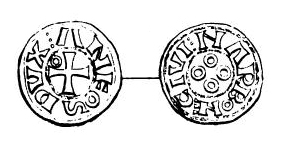Duke of Narbonne on:
[Wikipedia]
[Google]
[Amazon]
 The title Duke of Narbonne (''dux Narbonensis'') was a title employed at various times by the overlords of
The title Duke of Narbonne (''dux Narbonensis'') was a title employed at various times by the overlords of
''Robert Ier et Raoul de Bourgogne, rois de France (923-936)''.
1910.
 The title Duke of Narbonne (''dux Narbonensis'') was a title employed at various times by the overlords of
The title Duke of Narbonne (''dux Narbonensis'') was a title employed at various times by the overlords of Narbonne
Narbonne (, also , ; oc, Narbona ; la, Narbo ; Late Latin:) is a commune in France, commune in Southern France in the Occitania (administrative region), Occitanie Regions of France, region. It lies from Paris in the Aude Departments of Franc ...
, while the direct power in the city was held by the viscounts
A viscount ( , for male) or viscountess (, for female) is a title used in certain European countries for a noble of varying status.
In many countries a viscount, and its historical equivalents, was a non-hereditary, administrative or judicial ...
. The prestige of the title probable attached to the fact that Narbonne had been a capital of the ancient Roman
In modern historiography, ancient Rome refers to Roman civilisation from the founding of the city of Rome in the 8th century BC to the collapse of the Western Roman Empire in the 5th century AD. It encompasses the Roman Kingdom (753–509 BC ...
administration of the eponymous province of Gallia Narbonensis
Gallia Narbonensis (Latin for "Gaul of Narbonne", from its chief settlement) was a Roman province located in what is now Languedoc and Provence, in Southern France. It was also known as Provincia Nostra ("Our Province"), because it was the ...
.
On the death of his cousin Bertha of Rouergue in 1065, William IV of Toulouse
William IV of Toulouse ( 1040 – 1094) was Count of Toulouse, Margrave of Provence, and Duke of Narbonne from 1061 to 1094. He was the son of Pons of Toulouse and Almodis de la Marche. He was married to Emma of Mortain, daughter of Robert, ...
inherited the county of Narbonne. His brother and successor, Raymond IV Raymond IV may refer to:
* Raymond IV of Pallars Jussà (count, 1047–1098)
*Raymond IV, Count of Toulouse (r. 1094 - 1105), also count of Tripoli (1102–1105)
*Raymond IV, Count of Tripoli Raymond IVKevin James Lewis, ''The Counts of Tripoli and ...
, elevated the status to that of duke. Raymond's son and successor, Alfonso Jordan
Alfonso Jordan, also spelled Alfons Jordan or Alphonse Jourdain (1103–1148), was the Count of Tripoli (1105–09), Count of Rouergue (1109–48) and Count of Toulouse, Margrave of Provence and Duke of Narbonne (1112–48).
Life
Alfonso was the ...
, also employed the title with royal approval (as ''Amphusus dux Narbonensis provincie'') and his son, Raymond V
Raymond is a male given name. It was borrowed into English from French (older French spellings were Reimund and Raimund, whereas the modern English and French spellings are identical). It originated as the Germanic ᚱᚨᚷᛁᚾᛗᚢᚾᛞ ( ...
placed it first before his other titles as an implication of its importance (probably related to its Roman connection). The family was only dispossessed of the title when Raymond VI brought down the wrath of the French king for his supposed support of Cathar
Catharism (; from the grc, καθαροί, katharoi, "the pure ones") was a Christian dualist or Gnostic movement between the 12th and 14th centuries which thrived in Southern Europe, particularly in northern Italy and southern France. Follow ...
heresies.
In 1215, following the successes of the Albigensian Crusade
The Albigensian Crusade or the Cathar Crusade (; 1209–1229) was a military and ideological campaign initiated by Pope Innocent III to eliminate Catharism in Languedoc, southern France. The Crusade was prosecuted primarily by the French crown ...
, Philip II of France
Philip II (21 August 1165 – 14 July 1223), byname Philip Augustus (french: Philippe Auguste), was King of France from 1180 to 1223. His predecessors had been known as kings of the Franks, but from 1190 onward, Philip became the first French ...
granted Simon IV de Montfort, already Earl of Leicester
Earl of Leicester is a title that has been created seven times. The first title was granted during the 12th century in the Peerage of England. The current title is in the Peerage of the United Kingdom and was created in 1837.
Early creations ...
, the titles of Duke of Narbonne and Count of Toulouse. Arnauld Amaury, then Archbishop of Narbonne
The former Catholic diocese of Narbonne existed from early Christian times until the French Revolution. It was an archdiocese, with its see at Narbonne, from the year 445, and its influence ran over much of south-western France and into Cataloni ...
, also claimed the ducal dignity and entered a dispute with Simon which was not resolved before the latter's death (1218). The title thenceforth belonged to the archdiocese.
Sources
*Cheyette, Fredric L. ''Ermengard of Narbonne and the World of the Troubadours''. Cornell University Press: Ithaca, 2001. *Lauer, Philippe''Robert Ier et Raoul de Bourgogne, rois de France (923-936)''.
1910.
Notes